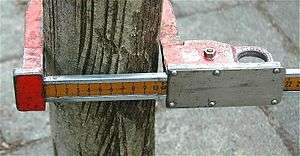Diameter at breast height
Diameter at breast height, or DBH, is a standard method of expressing the diameter of the trunk or bole of a standing tree. DBH is one of the most common dendrometric measurements.

Tree trunks are measured at the height of an adult's breast. However, this is defined differently in different countries and situations. The convention is now 1.3 m above ground level. In many countries the diameter has been measured usually at 1.3 metres above ground.[1], [2] In some countries, such as Australia, New Zealand, Burma, India, Malaysia, and South Africa, breast height diameter has been measured at a height of 1.4 metres, but because of much active research into allometrics that are being applied to trees and forests, the convention of 1.3 m is more appropriate. Previously 4.5 ft (1.37 m) was used.[3] The height can make a substantial difference to the measured diameter [4]. Ornamental trees are usually measured at 1.5 metres above ground.
However, some authors[5] maintain that the term DBH should be abolished because the heights at which the diameter is measured are so variable and because it may strongly influence forestry calculations such as biomass. Instead Dx was proposed whereby the x denotes the exact height above the floor (and along the stem) at which the diameter is measured. For instance D130 denotes a diameter measured at 130 cm above the floor and along the stem.
On sloping ground, the "above ground" reference point is usually taken as the highest point on the ground touching the trunk, but some use the average between the highest and lowest points of ground. If the DBH point falls on a swelling in the trunk it is customary to measure the girth below the swelling at the point where the diameter is smallest. Other ambiguous settings for determining the exact place where to measure the diameter is given in Dahdouh-Guebas & Koedam (2006).[6]
Treetec, a company based in Melbourne, has created a free online calculator to determine the DBH for multi-stemmed trees as per AS 4970-2009 Protection of Trees on Development Sites.[7]
The two most common instruments used to measure DBH are a girthing (or diameter) tape and calipers.
A girthing tape actually measures the girth (circumference) of the tree; the girthing tape is calibrated in divisions of π centimetres (3.14159 cm). The measure assumes the trunk has a circular cross-section and gives a directly converted reading of the diameter. It is accurate for most plantation trees.
Calipers consist of two parallel arms one of which is fixed and the other able to slide along a scale. Calipers are held at right-angles to the trunk with the arms on either side of the trunk. Precision can be improved on non-circular stems by averaging two caliper measurements taken at right-angles. Electronic calipers are also available enabling highly accurate measurements to be taken and stored for further analysis.
DBH is used in estimating the amount of timber volume in a single tree or stand of trees utilising the allometric correlation between stem diameter, tree height and timber volume, (Mackie, 2006). It can also be used in the estimation of the age of veteran trees, given that diameter increment is the only "constant non-reversible feature of tree growth" (White, 1998).
See also
References
- ↑ Cris Brack, PhD (UBC) Standard point on tree bole for measurement. Forest Measurement and Modelling. Retrieved 2009-04-18.
- ↑ Feldpausch et al 2011, Height-diameter allometry of tropical forest trees. Biogeosciences 8, 1081-1106.
- ↑ Russell M. Burns and Barbara H. Honkala Silvics Manual, Volume 2, Glossary (USDA Forest Service)
- ↑ Paul, K.I. et al. 2017. Measurements of stem diameter: implications for individual- and stand-level errors. Environmental Monitoring and Assessment 189, 416.
- ↑ Brokaw, N. & J. Thompson, 2000. The H for DBH. Forest Ecology and Management 129: 89-91.
- ↑ Dahdouh-Guebas, Farid; Koedam, Nico (15 June 2006). "Empirical estimate of the reliability of the use of the Point-Centred Quarter Method (PCQM): Solutions to ambiguous field situations and description of the PCQM+ protocol". Forest Ecology and Management. 228 (1): 1–18. doi:10.1016/j.foreco.2005.10.076 – via ScienceDirect.
- ↑ Cashmore, Mark. "TREETEC - Tree Protection Zone (TPZ), Structural Root Zone (SRZ), DBH calculator". www.treetec.net.au.
- Brokaw, N. and Thompson, J. (2000). The H for DBH. Forest Ecology and Management 129: 89-91.
- Hamilton, G. J. (1975). Forest Mensuration Handbook. Forestry Commission Booklet 39. HMSO, London.
- Mackie, E. D. and Matthews, R. W. (2006). Forest Mensuration, a handbook for practitioners. HMSO, Edinburgh. ISBN 0-85538-621-5
- White, J. (1998). Estimating the Age of Large and Veteran Trees in Britain. Forestry Commission Information Note 12. Surrey.
